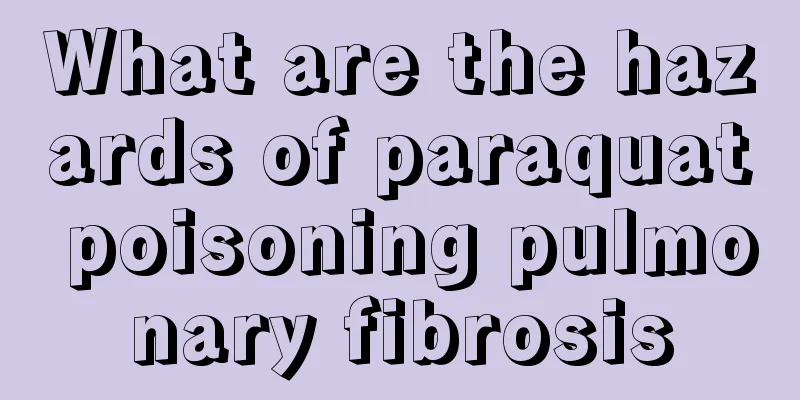What are the hazards of paraquat poisoning pulmonary fibrosis

|
Paraquat is a pesticide widely used in rural areas. Due to its strong toxicity, the damage it causes to the human body is often fatal. In many rural areas, paraquat poisoning due to accidental ingestion or poisoning often directly causes respiratory and lung problems, among which lung tissue damage is the most serious. Pulmonary fibrosis caused by paraquat poisoning is also a common sequelae of poisoning. Pulmonary fibrosis is the most serious disease in paraquat poisoning The chemical name of paraquat is 1-1-dimethyl-4-4-bipyridinium chloride, also known as paraquat, chloranil, and paraquat. Accidental oral ingestion of more than 30 ml of 20% aqueous solution can cause death. Paraquat can be absorbed through the skin, respiratory tract and digestive tract, but the absorption is not complete. After absorption, it is distributed to various tissues and organs throughout the body with the blood, but the content in the lung tissue is the highest. Paraquat is rarely degraded in the body and is often excreted in its original form in feces and urine. A small amount can be excreted through breast milk. 1. Causes damage to multiple systems Paraquat poisoning can cause damage to multiple systems, especially pulmonary fibrosis, which is the most serious. It can cause congestion, hemorrhage, edema, hyaline membrane formation, degeneration, hyperplasia, fibrosis and other changes in lung tissue. Large-dose poisoning often causes death due to respiratory failure and multiple organ failure such as heart, liver, and kidney caused by acute lung injury; smaller-dose poisoning often causes later lung tissue fibrosis, with a relatively long course of disease. Progressive, diffuse, and irreversible pulmonary fibrosis is the main cause of death in patients who survive the acute phase of poisoning. 2. Induce acute inflammatory response in lung tissue, causing acute lung damage and leading to alveolitis The main target organ of paraquat poisoning is the lung tissue. It can be actively transported and taken up into the lung type I and II cells, making the concentration of paraquat in the lung tissue 6-10 times higher than the plasma concentration. It can also cause redox reactions in the cells. The oxygen free radicals converted in cells are the basis of paraquat's toxic effects. The large amount of superoxide anion free radicals (O=) and hydrogen peroxide (H2O2) formed can induce acute inflammatory response in lung tissue, causing acute lung damage and leading to alveolitis. Pathological changes in lung tissue after paraquat poisoning 1. After paraquat poisoning, it induces inflammatory cell aggregation and cytokine activation, generating a large amount of fibrinous inflammatory exudate, filling the small bronchi and alveoli of the lungs with protein inflammatory exudate, inflammatory cells and degenerated bronchial epithelial cells caused by poisoning, causing the degeneration of type II alveolar epithelial cells and the formation of hyaline membranes, affecting the secretion of surfactant by alveolar epithelial cells. 2. Reduced secretion or impaired secretion of pulmonary surfactant causes the alveolar wall to collapse. The collapsed alveolar cavity and the exposed alveolar wall adhere to each other through protein substances such as cellulose, resulting in occlusion and disappearance of the alveolar cavity. 3. Inflammatory cells and cytokines stimulate and activate the originally dormant fibroblasts, transforming them into myofibroblasts. On the one hand, it proliferates in the pulmonary interstitium and secretes a large amount of matrix proteins, causing pulmonary interstitial fibrosis. On the other hand, it is induced by the chemotaxis produced by inflammatory factors and cytokines in the alveoli, enters the alveolar cavity through the damaged alveolar epithelium and basement membrane and proliferates, secreting a large amount of matrix proteins. The blocked alveolar cavity is eventually filled and replaced by matrix proteins, resulting in irreversible alveolar fibrosis. This causes fibrosis of the entire lung tissue, leading to respiratory failure and death. Irreversible fibrosis of lung tissue caused by paraquat poisoning is the main cause of death from paraquat poisoning. It is hoped that clinicians can be inspired and learn from this to intervene artificially and prevent the occurrence of irreversible fibrosis of lung tissue. Strive to cure more patients suffering from paraquat poisoning. |
<<: What medicine is good for arteriosclerosis?
>>: What are the causes of atherosclerosis
Recommend
Traditional Chinese medicine prescription for advanced lymphoma
Lymph is the largest immune organ in the body. Wh...
How to treat alopecia areata? What should I do if I have alopecia areata?
A very common cause of alopecia areata is mental ...
Are more and more people susceptible to allergies because the environment is too clean?
Why are people becoming more and more susceptible...
Why do my limbs feel sore and weak when I wake up in the morning?
Feeling weak and sore in the limbs when waking up...
How much does it cost to check for ovarian tumors?
The ovaries are important reproductive organs for...
Can pituitary tumors be cured by taking medicine?
In most cases, pituitary tumors are difficult to ...
What is the fastest way to remove acne scars
When you see the pimples on your face slowly disa...
What to do if your vocal cords bleed? Here are some effective methods for you
Patients with vocal cord congestion must pay atte...
How to remove nail sweat odor
The removal of body odor should require correct m...
Analysis of several common causes of colon cancer
Colon cancer is a common disease in life. After s...
What are some foods high in potassium? It is contained in them!
1. Potassium is an essential trace element in the...
What to do if you have hemorrhoids
With the increasing pressure of modern people'...
Redness and fever on face
Whether for women or men, facial skin is very imp...
Dietary considerations for nasopharyngeal carcinoma patients during the recovery period
During the recovery period, patients with nasopha...
How long can I last in this situation with advanced gastric cancer
Patients with advanced gastric cancer can general...









